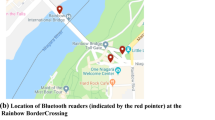Abstract
This paper analyzes the impact of stock market indices, as indicators of political and economic stability, and other regional exogenous factors on the performance of predictive modeling of border traffic using neural network models. To prove the concept, the Saudi–Bahrain corridor through King Fahd causeway is selected as our area of study. These two countries have strong cultural ties and a wide variety of variables affects the incoming and outgoing traffic flows. Various models of artificial neural networks are constructed for different prediction horizons and look-back periods using a dataset prepared for the period from 2003 till 2013. In our study, stock market indices are proposed, for the first time, to be used in border traffic forecasting. These indices are added as a surrogate measure of the political and economic conditions of the countries which are under study. Their effects on models with varying ranges of time-series inputs and different prediction horizons are studied in detail. It is found that including stock market indices and other most relevant local factors has generally improved the prediction performance of the neural network models in all cases. Additional reduction in the prediction error is achieved by the proposed ensemble model trained with different time lags. Yet, the degree of improvement depends on the look-ahead horizon for prediction.
Similar content being viewed by others
References
Khattak A.J., De Palma A.: The impact of adverse weather conditions on the propensity to change travel decisions: a survey of brussels commuters. Transp. Res. Part A Policy Pract. 31(3), 181–203 (1997)
Moorthy C.K., Ratcliffe B.G.: Short term traffic forecasting using time series methods. Transp. Plan. Technol. 12(1), 45–56 (1988)
Mai, T.; Ghosh, B.; Wilson, S.: Short-term traffic-flow forecasting with auto-regressive moving average models. In: Proceedings of the ICE—Transport (2013)
Guo F., Krishnan R., Polak J.: A computationally efficient two-stage method for short-term traffic prediction on urban roads. Transp. Plan. Technol. 36(1), 62–75 (2013)
Karlaftis M., Vlahogianni E.: Statistical methods versus neural networks in transportation research: differences, similarities and some insights. Transp. Res. Part C Emerg. Technol. 19(3), 387–399 (2011)
Yin H., Wong S., Xu J., Wong C.: Urban traffic flow prediction using a fuzzy-neural approach. Transp. Res. Part C Emerg. Technol. 10(2), 85–98 (2002)
Dimitriou L., Tsekeris T., Stathopoulos A.: Adaptive hybrid fuzzy rule-based system approach for modeling and predicting urban traffic flow. Transp. Res. Part C Emerg. Technol. 16(5), 554–573 (2008)
Zhang Y., Liu Y.: Traffic forecasting using least squares support vector machines. Transportmetrica 5(3), 193–213 (2009)
Suykens J., Vandewalle J., De Moor B.: Optimal control by least squares support vector machines. Neural Netw. 14(1), 23–35 (2001)
Saneinejad S., Roorda M.J., Kennedy C.: Modelling the impact of weather conditions on active transportation travel behaviour. Transp. Res Part D Transp. Environ. 17(2), 129–137 (2012)
Aultman-Hall L., Lane D., Lambert R.R.: Assessing impact of weather and season on pedestrian traffic volumes. Transp. Res. Rec. J. Transp. Res. Board 2140(1), 35–43 (2009)
Clifton, K.J.; Chen, R.B.; Cutter, A.: Representing weather in travel behaviour models: a case study from Sydney, Australia. In: Australasian Transport Research Forum 2011 Proceedings, pp. 28–30 (2011)
Tsirigotis L., Vlahogianni E.I., Karlaftis M.G.: Does information on weather affect the performance of short-term traffic forecasting models?. Int. J. Intell. Transp. Syst. Res. 10(1), 1–10 (2012)
Dougherty M.S., Cobbett M.R.: Short-term inter-urban traffic forecasts using neural networks. Int. J. Forecast. 13(1), 21–31 (1997)
Lingras, P.; Mountford, P.: Time delay neural networks designed using genetic algorithms for short term inter-city traffic forecasting. In: Engineering of Intelligent Systems, pp. 290–299. Springer, Berlin (2001)
KFCA Authority: King Fahd causeway authority passenger statistics (2012). http://www.kfca.com.sa
Adhikari R., Agrawal R.K.: A homogeneous ensemble of artificial neural networks for time series forecasting. Int. J. Comput. Appl. 32(7), 1–8 (2011)
Lin J., Zhu B.: A novel neural network ensemble system for economic forecasting. In: Huang, D.S., Heutte, L., Loog, M. (eds) Advanced Intelligent Computing Theories and Applications. With Aspects of Contemporary Intelligent Computing Techniques, vol. 2, pp. 1227–1233. Springer, Berlin (2007)
Hyndman R.J., Koehler A.B.: Another look at measures of forecast accuracy. Int. J. Forecast. 22(4), 679–688 (2006)
Armstrong J., Collopy F.: Error measures for generalizing about forecasting methods: empirical comparisons. Int. J. Forecast. 8(1), 69–80 (1992)
Benesty, J.; Chen, J.; Huang, Y.; Cohen, I.: Pearson correlation coefficient. In: Noise Reduction in Speech Processing, Springer Topics in Signal Processing, vol. 2, pp. 1–4. Springer, Berlin (2009)
Al-Ahmadi H.: Development of intercity mode choice models for Saudi Arabia. J. King Abdulaziz Univ. Eng. Sci. 17(1), 3–20 (2006)
Bullock, D.; Catarella, A.: A real-time simulation environment for evaluating traffic signal systems. Transp. Res. Rec. J. Transp. Res. Board 1634, 130–135 (1998)
Author information
Authors and Affiliations
Corresponding author
Additional information
E.-S. M. El-Alfy is on leave from the College of Engineering, Tanta University, Egypt.
Rights and permissions
About this article
Cite this article
El-Alfy, ES.M., Ratrout, N.T. & Gazder, U. Impact of Stock Market Indices and Other Regional Exogenous Factors on Predictive Modeling of Border Traffic with Neural Network Models. Arab J Sci Eng 40, 303–312 (2015). https://doi.org/10.1007/s13369-014-1438-3
Received:
Accepted:
Published:
Issue Date:
DOI: https://doi.org/10.1007/s13369-014-1438-3




